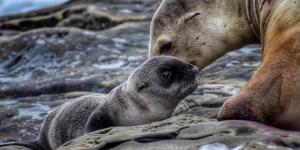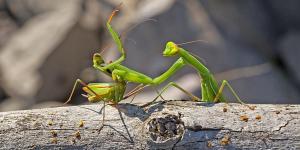How Do Penguins Mate and Reproduce?


Penguins are widely known for their distinctive black and white plumage, upright posture, and waddling gait. In addition to their unique appearance, however, penguins also exhibit a variety of interesting behaviors. Penguins are very social and live in large colonies, sometimes numbering in the millions. They have a complex social structure that includes a range of behaviors such as calling, preening and courtship. They are also known for their unique reproductive behavior, including forming monogamous pairs and incubating eggs together by both parents.
This article from AnimalWised explains how penguins mate and reproduce and provides many other fascinating facts about the behavior of these fascinating animals.
What are penguins?
Penguins are a group of flightless birds that are very well adapted to life in water. They are found mainly in the Southern Hemisphere, especially in Antarctica, South Africa, New Zealand, Australia, and the southern tip of South America.
Unlike many other bird species, which use their wings for both flying and swimming, penguins use their wings (flippers) exclusively for swimming and diving. Penguins also have a streamlined body shape that allows them to swim quickly through the water. In fact, they are excellent swimmers, with some species able to swim up to 22 miles (ca. 35 km) per hour. On land, however, penguins are clumsy and waddle awkwardly because of their short legs and heavy bodies.
Furthermore, penguins have a number of adaptations that help them survive in their harsh environments. These include a counter-current heat exchange system that prevents them from losing body heat through their feet, and the ability to drink seawater and excrete excess salt through their nasal glands.
How many species of penguins are there?
There are 18 species of penguins, each with unique physical characteristics and adaptations that allow them to survive in their respective environments.
Each of these species has its own unique behaviors, nesting habits, and distribution patterns. The environment in which penguins live has a significant impact on how they mate and reproduce.
If you want to learn more about these fascinating animals, do not miss this other article, where we have listed some interesting facts about penguins.
How do penguins mate and reproduce?
As mentioned earlier, the way penguins mate and reproduce varies depending on the species and environment in which they live. Factors such as food availability, for example, are critical to penguin reproduction. In areas where food is scarce, such as around the Antarctic Peninsula, penguins may skip a breeding season if their energy reserves are low. This can have long-term effects on the population, as fewer offspring are produced and the population may decline.
Despite the differences in the way penguins reproduce, there are some common elements for all species. Firstly, penguins reproduce sexually, with a male and a female mating to produce offspring. Furthermore, penguins are oviparous, which means that they reproduce by laying eggs. All penguins breed only once a year, during a specific season that varies depending on the species and location.
Finally, for all species, the reproductive process typically involves several stages, including courtship, physical copulation, egg-laying, and incubation.
Courtship
Penguin courtship rituals also vary from species to species. In all species, however, courtship includes displays and behaviors that help attract a mate and establish a bond between the pair. Some of the most common behaviors are:
- Bowing: penguins may bow to each other as a sign of submission or respect. In most cases, is the male that bows.
- Vocalizations: penguins have a range of sounds that they use to communicate with each other, and these sounds play an important role in courtship. During courtship, males may call females to attract their attention and establish a bond.
- Preening: plumage preening is an essential part of penguin courtship. Males may groom females as a sign of affection, and both mates may groom each other to strengthen their bond.
- Building a nest: in many penguin species, males establish a territory and build a nest of stones, pebbles, and other materials. They then engage in courtship by bowing, calling, and flapping their wings to attract a mate.
- Ritualized dancing: once a female has chosen a male, the pair performs a ritualized dance in which their beaks touch and their voices ring out. This helps strengthen the bond between the pair and ensure they are compatible.
Physical copulation
When it is time to mate, the male approaches the female, stands behind her and places his flippers on her shoulders. He then arches his back and stretches his cloaca (an opening used for both reproduction and excretion) toward the female's cloaca. The male then transfers his sperm into the female's cloaca, where it fertilizes her eggs.
Egg-laying
In penguins, egg laying is a critical stage in their reproductive cycle. The timing of egg laying in penguins can vary by species and geographic location. However, most penguin species lay their eggs during spring or summer, when temperatures are slightly warmer and there is more daylight.
Before laying an egg, female penguins often fast for several days, drawing on their fat reserves to provide the energy needed to lay the egg.
After the nest is built, the female penguin lays one or two eggs, depending on the species. The egg is relatively large compared to the size of the parent and is enclosed in a hard, calcified shell to protect the developing embryo inside.
Incubation
Both parents take turns incubating the eggs by sitting on them to keep them warm. This can take various weeks depending on the species.
The incubation period is a critical time for the developing embryo, as it needs a constant, warm temperature to develop properly. To keep the egg warm, the parent penguin hides it under a fold of skin called the brood patch, which is located on the bird's abdomen. The brood patch is a special area of skin that is rich in blood vessels, allowing the parent penguin to transfer heat directly to the egg.
During the incubation period, parents also take turns leaving the egg to feed in the sea. This can be a difficult time for the parents, as they must balance the need to feed themselves with the need to protect their developing offspring.

Do penguins mate for life?
Many penguin species form long-term pair bonds, with some individuals mating for life. However, not all penguins mate for life, and the duration of pair bonds can vary among species.
Emperor penguins (Aptenodytes forsteri), for example, are known to form monogamous pair bonds that can last several years, with some individuals returning to the same breeding site each year to mate. Adelie penguins (Pygoscelis adeliae) are also known to form long-term pair bonds that can last numerous breeding seasons.
Other penguin species, such as Gentoo penguins (Pygoscelis papua) and Macaroni penguins (Eudyptes chrysolophus), form pair bonds that can last only one breeding season. After the breeding season, these birds may find new mates the following breeding season.
Despite the varying duration of pair bonds, penguins are known for their strong social bonds and cooperative breeding behavior, in which both parents share the responsibility of caring for their young.
Did you know that penguins are among the best parents in the animal kingdom? Learn more about it and more in this article on the best animal dads.

How do penguins care for their young?
Parents of penguins care devotedly for their young, which is a complex and demanding process.
Once the chick hatches from the egg, they are covered with a soft, downy coat of feathers that provides insulation and helps regulate its body temperature.
In the first few days after hatching, the chick relies on a nutrient-rich yolk sac ingested just before hatching. This provides the chick with the energy it needs to survive until it is strong enough to leave the nest and forage with its parents.
As the chick grows, its downy feathers are replaced by waterproof adult feathers that protect it from the cold waters. As the chick grows older and stronger, it begins to explore its environment and learns to care for itself. However, the parents will continue to care for the chick until it is old enough to fledge or leave the nest and forage for food on its own.
How long penguins take care of their young depends on the species, but can generally range from a few weeks to several months. Emperor penguins (Aptenodytes forsteri), for example, which have one of the longest breeding cycles of any penguin species, care for their young for up to 4 months.
As you can see, penguins are not only amazing parents, but they also form strong pair bonds with their mates. Do not miss this other article if you want to learn more about what other animals are loyal to their mates.

If you want to read similar articles to How Do Penguins Mate and Reproduce?, we recommend you visit our Facts about the animal kingdom category.
- Jadwiszczak, P. (2009). Penguin past: The current state of knowledge. Polish polar research , 30(1), 3-28.
- Davis, LS, & Renner, M. (2010). Penguin . Bloomsbury Publishing.
- Emperor Penguin. 2019, from National Geographic Website: https://www.nationalgeographic.com/animals/birds/e/emperor-penguin/
- John P. Rafferty. Emperor penguin. 2019, from Encyclopaedia Britannica Website: https://www.britannica.com/animal/emperor-penguin
- Jean Prevost, Frank Gill. (08.09.2019). Penguin. 2019, from Encyclopaedia Britannica Website: https://www.britannica.com/animal/penguin








